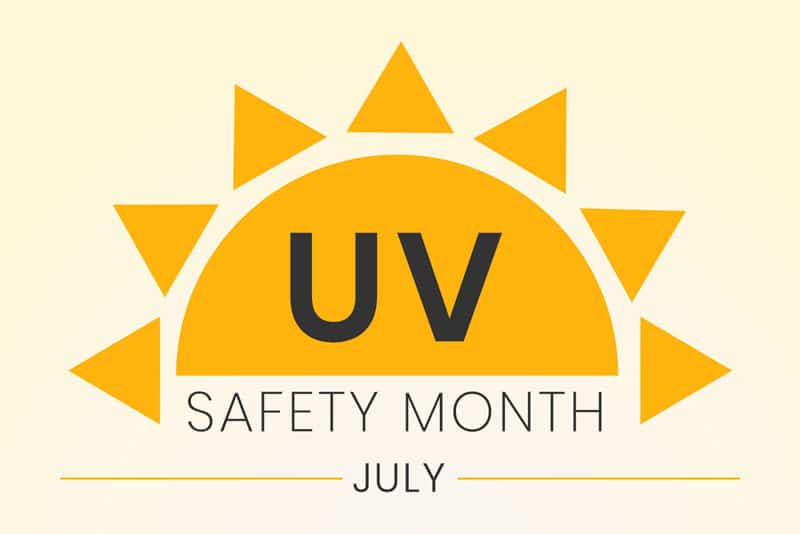Staying Safe in Sunny Weather

It’s essential to protect your skin and eyes from too much UV exposure throughout the year
The risks of too much sun exposure
Many of us look forward to bright and sunny weather because of the numerous recreational activities we enjoy. Regardless of the season, too much exposure to the sun can prove hazardous to your health. This sun damage is caused by invisible ultraviolet (UV) radiation.
Spending too much time under these UV rays can cause sunburn, skin aging, eye damage, and skin cancer. Skin aging includes skin spots, wrinkles, and “leathery skin.” In fact, research indicates that UV exposure is responsible for up to 80% of the visible signs of facial aging.
The American Cancer Society estimates that about 99,780 new cases of melanoma (skin cancer) will be diagnosed in the U.S. during 2022 (around 57,180 men and 42,600 women). Furthermore, it is expected that melanoma will contribute to the death of approximately 7,650 people during the same year (about 5,080 men and 2,570 women.)
Thus, we encourage everyone to protect their skin and eyes from sun damage throughout the year.
How you can reduce your risk for sun damage:
- Limit your time in the sun, especially between 10 a.m. and 4 p.m., when the sun’s rays are most intense.
- Wear clothing to cover skin exposed to the sun, such as long-sleeve shirts, pants, sunglasses, and broad-brim hats.
- Use broad-spectrum sunscreens with an SPF (sun protection factor) of 15 or higher regularly and as directed (even on cloudy days).
- Consult a health care professional before applying sunscreen to infants younger than six months.
- Apply sunscreen liberally to all uncovered skin, especially your nose, ears, neck, hands, feet, and lips (but avoid getting it inside your mouth and eyes).
- Reapply sunscreen at least every two hours. Apply more often if you’re swimming or sweating. (Read the label for your specific sunscreen.)
- If you don’t have much hair, apply sunscreen to the top of your head or wear a hat for protection.
(Source: U.S. Food and Drug Administration recommendations)
Facts about sunscreens
- Sunscreens are available as lotions, creams, sticks, gels, oils, butter, pastes, and sprays. Unfortunately, there is no sunscreen that completely blocks all UV radiation.
- Some sunscreens may be water-resistant, but the FDA warns there is no such thing as a “waterproof sunscreen.”
- Although UVB rays are the primary cause of sunburn, both UVA and UVB rays contribute to skin cancer.
All sunscreens help protect against sunburn. However, only broad-spectrum sunscreens reduce the risk of skin cancer and early skin aging caused by UVA and UVB rays when used as directed (along with other protective measures if needed).
Risk factors for harmful effects of UV radiation
People of all skin colors are potentially at risk for sunburn and other harmful effects of UV radiation, so always protect yourself. Be especially careful if you:
- Previously had skin cancer
- Have a family history of skin cancer, especially melanoma
- Spend a lot of time outdoors
- Have many moles, irregular moles, or large moles
- Have freckles and burn before tanning
- Have fair skin, blue or green eyes, or blond, red, or light brown hair
- Work all week indoors and then get intense sun exposure on weekends
- Have a medical condition that weakens your immune system, such as infection with HIV (the virus that causes AIDS)
- Have had an organ transplant
- Take medicines that make your skin more sensitive to sunlight
(A complete list is available from the American Cancer Society)
While everyone should protect themselves against UV radiation, it is essential to protect children. Most of an average person's UV exposure occurs before age 18. Too much UV exposure or frequent sunburns, particularly during childhood, can make developing skin cancer more likely.
If you are a person who has a job or lifestyle with excessive sun exposure, or if you have multiple, new, or irregular skin lesions, please see a physician annually for a skin examination. Follow your physician’s advice for skin protection and care.
Protect your eyes with sunglasses
Sunlight reflecting off sand, water, or even snow, further increases exposure to UV radiation and your risk of developing eye problems. Specific sunglasses can help protect your eyes.
When using sunglasses, the U.S. Food and Drug Administration recommends:
- Choose sunglasses with a UV400 rating or “100% UV protection” on the label. These sunglasses block more than 99% of UVA and UVB radiation and provide the most protection against UV rays.
- Make sure your tinted, darkened, or colored glasses have UV protection. The darkness of the lens does not indicate its ability to shield your eyes from UV rays.
- Be aware that children should wear sunglasses indicating UV protection level. Toy sunglasses may not have this, so look for the UV protection label.
- Consider large, wraparound-style frames, which may provide more UV protection because they cover the entire eye socket.
Enjoying your time under the sun
The Moultrie County Health Department wishes everyone a wonderful and safe summer season under the sun in our great outdoors!

